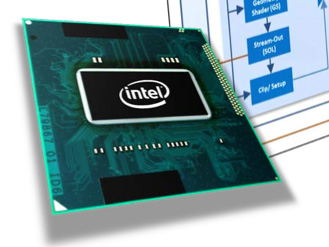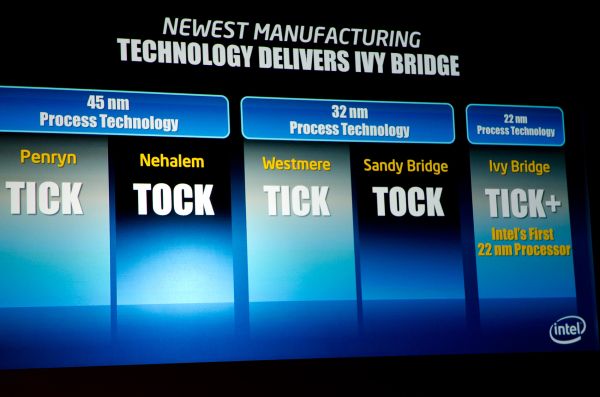The Ivy Bridge Preview: Core i7 3770K Tested
by Anand Lal Shimpi on March 6, 2012 8:16 PM EST- Posted in
- CPUs
- Intel
- Core i7
- Ivy Bridge
Note: This preview was not sanctioned or supported by Intel in any way.
I still remember hearing about Intel's tick-tock cadence and not having much faith that the company could pull it off. Granted Intel hasn't given us a new chip every 12 months on the dot, but more or less there's something new every year. Every year we either get a new architecture on an established process node (tock), or a derivative architecture on a new process node (tick). The table below summarizes what we've seen since Intel adopted the strategy:
| Intel's Tick-Tock Cadence | |||||
| Microarchitecture | Process Node | Tick or Tock | Release Year | ||
| Conroe/Merom | 65nm | Tock | 2006 | ||
| Penryn | 45nm | Tick | 2007 | ||
| Nehalem | 45nm | Tock | 2008 | ||
| Westmere | 32nm | Tick | 2010 | ||
| Sandy Bridge | 32nm | Tock | 2011 | ||
| Ivy Bridge | 22nm | Tick | 2012 | ||
| Haswell | 22nm | Tock | 2013 | ||
Last year was a big one. Sandy Bridge brought a Conroe-like increase in performance across the board thanks to a massive re-plumbing of Intel's out-of-order execution engine and other significant changes to the microarchitecture. If you remember Conroe (the first Core 2 architecture), what followed it was a relatively mild upgrade called Penryn that gave you a little bit in the way of performance and dropped power consumption at the same time.

Ivy Bridge, the tick that follows Sandy Bridge, would typically be just that: a mild upgrade that inched performance ahead while dropping power consumption. Intel's microprocessor ticks are usually very conservative on the architecture side, which limits the performance improvement. Being less risky on the architecture allows Intel to focus more on working out the kinks in its next process node, in turn delivering some amount of tangible power reduction.
Where Ivy Bridge shakes things up is on the graphics side. For years Intel has been able to ship substandard graphics in its chipsets based on the principle that only gamers needed real GPUs and Windows ran just fine on integrated graphics. Over the past decade that philosophy required adjustment. First it was HD video decode acceleration, then GPU accelerated user interfaces and, more recently, GPU computing applications. Intel eventually committed to taking GPU performance (and driver quality) seriously, setting out on a path to significantly improve its GPUs.
As Ivy is a tick in Intel's cadence, we shouldn't see much of a performance improvement. On the CPU side that's mostly true. You can expect a 5 - 15% increase in performance for the same price as a Sandy Bridge CPU today. A continued desire to be aggressive on the GPU front however puts Intel in a tough spot. Moving to a new manufacturing process, especially one as dramatically different as Intel's 22nm 3D tri-gate node isn't easy. Any additional complexity outside of the new process simply puts schedule at risk. That being said, its GPUs continue to lag significantly behind AMD and more importantly, they still aren't fast enough by customer standards.
Apple has been pushing Intel for faster graphics for years, having no issues with including discrete GPUs across its lineup or even prioritizing GPU over CPU upgrades. Intel's exclusivity agreement with Apple expired around Nehalem, meaning every design win can easily be lost if the fit isn't right.
With Haswell, Intel will finally deliver what Apple and other customers have been asking for on the GPU front. Until then Intel had to do something to move performance forward. A simple tick wouldn't cut it.

Intel calls Ivy Bridge a tick+. While CPU performance steps forward, GPU performance sees a more significant improvement - in the 20 - 50% range. The magnitude of improvement on the GPU side is more consistent with what you'd expect from a tock. The combination of a CPU tick and a GPU tock is how Intel arrives at the tick+ naming. I'm personally curious to see how this unfolds going forward. Will GPU and CPUs go through alternating tocks or will Intel try to synchronize them? Do we see innovation on one side slow down as the other increases? Does tick-tock remain on a two year cadence now that there are two fairly different architectures that need updating? These are questions I don't know that we'll see answers to until after Haswell. For now, let's focus on Ivy Bridge.










195 Comments
View All Comments
Mithan - Wednesday, March 7, 2012 - link
Most gamers don't spend money on the I7 lineup, prefering to buy the Core i5 series and invest the extra money into more GPU.just4U - Thursday, March 8, 2012 - link
It's not only the extra money.. Apparently the 2500K does better in a fair number of games over the 2600K (in part.. i think due to Hyper Threading) and the graphs seem to support that (altho maybe not for the reason I mentioned)Looking at the 3700 series though it beats out both the 2500K and 2600K so I think that one is going to be of special interest to gamers.. moving forward.
auvrea - Monday, November 19, 2012 - link
bumpnuha_te10 - Tuesday, March 6, 2012 - link
I'm afraid the next Haswell will be Tock-Arnulf - Wednesday, March 7, 2012 - link
Why ?If the statement "the significant gains we're seeing here with Ivy will pale in comparison to what Haswell provides" is true then I'm looking forward to Haswell very much. I'll finally be able to dump discrete GPU as I only use relatively mdoest dislay resolutions, and instead pour the money into even quieter cooling solution. Silence, sweet silence :)
Articuno - Tuesday, March 6, 2012 - link
Nice to see AMD winning where it actually matters for most consumer applications.Exodite - Wednesday, March 7, 2012 - link
Browsing?Fujikoma - Wednesday, March 7, 2012 - link
You crack me up... that was truly a funny response.Seriously though, Llano isn't that bad for a generic/cheap build. I did pick one up to build a machine for my mom. The mobo and the proc. were justified by the price. I knew it wouldn't be powerful, but it's fairly energy efficient, has decent graphics and the money I saved went toward the ssd. Most people I build/fix computers for, don't come close to using them to their potential, so price becomes the biggest factor. Would I buy one for myself? No, I'll stick with the i7 I currently have and when I build my next machine, it looks like it'll be an Intel also.
Exodite - Wednesday, March 7, 2012 - link
Thanks. :)I quite agree, Llano is awesome for what it does and provides an excellent platform for most users.
I'm just tired of the assumption that GPU grunt is more powerful than CPU.
It's true that most of my friends and family would be perfectly happy with the GPU muscle in a Llano chip. That said, they'd also be perfectly happy with the iGPU in something like a i3 2100.
As for myself I'm using an i7 2600K, running at stock, but then I have somewhat different requirements.
I'd not hesitate to recommend either Llano or Intel chips with iGPU solutions, it all depends on the person really.
Exodite - Wednesday, March 7, 2012 - link
...'GPU grunt is more important that CPU'... would probably read better, looking back.Ah well, you get the point I'm sure.